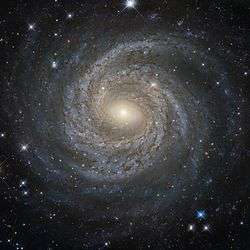NGC 6814
| NGC 6814 | |
|---|---|
 NGC 6814 by Hubble Space Telescope | |
| Observation data (J2000 epoch) | |
| Constellation | Aquila |
| Right ascension | 19h 42m 40.6s[1] |
| Declination | −10° 19′ 25″[1] |
| Redshift | 1563 ± 2 km/s[1] |
| Distance | 74 Mly (22.8 Mpc)[1] |
| Apparent magnitude (V) | 12.1 |
| Characteristics | |
| Type | SAB(rs)bc [1] |
| Apparent size (V) | 3′.0 × 2′.8[1] |
| Other designations | |
| MCG -02-50-001, PGC 63545[1] | |
NGC 6814 is an intermediate spiral galaxy in constellation Aquila. It is located at a distance of about 75 million light years from Earth, which, given its apparent dimensions, means that NGC 6814 is about 85,000 light years across. NGC 6814 has an extremely bright nucleus and is a type 1.5 Seyfert galaxy. The galaxy is also a highly variable source of X-ray radiation. The ultraviolet and optical emission also varies, although more smoothly, with time lag of two days. The cause of the lag and the smoothing of light curves is considered to be the reprocessing of the X-rays in the accretion disk.[2] The cause of the active galactic nucleus is suspected to be a supermassive black hole with a mass about 18 million times that of the Sun. Many regions of ionised gas are studded along the dusty spiral arms.[3]
References
- 1 2 3 4 5 6 7 "NASA/IPAC Extragalactic Database". Results for NGC 6814. Retrieved 2016-01-18.
- ↑ Troyer, Jon; Starkey, David; Cackett, Edward M.; Bentz, Misty C.; Goad, Michael R.; Horne, Keith; Seals, James E. (14 January 2016). "Correlated X-ray/ultraviolet/optical variability in NGC 6814". Monthly Notices of the Royal Astronomical Society. 456 (4): 4040–4050. arXiv:1509.01124. Bibcode:2016MNRAS.456.4040T. doi:10.1093/mnras/stv2862.
- ↑ "A spiral snowflake". www.spacetelescope.org. 9 May 2016. Retrieved 13 March 2017.
External links
- NGC 6814 on WikiSky: DSS2, SDSS, GALEX, IRAS, Hydrogen α, X-Ray, Astrophoto, Sky Map, Articles and images